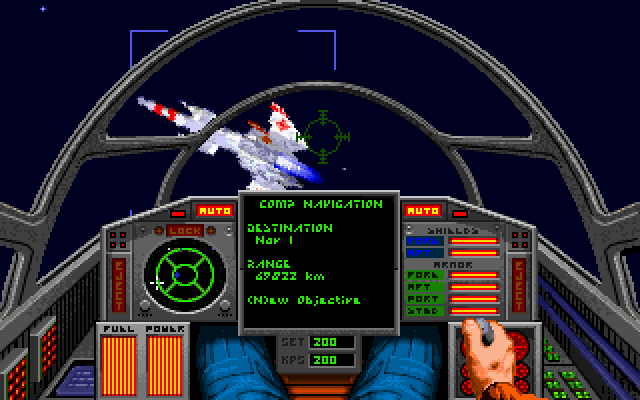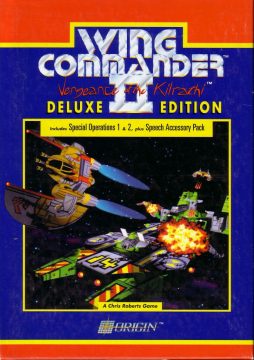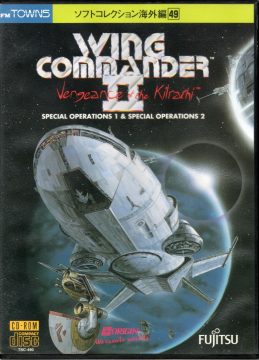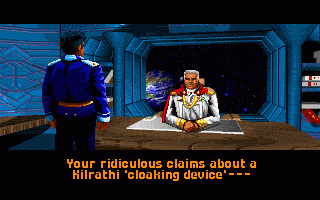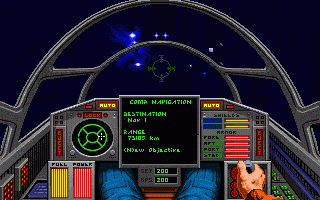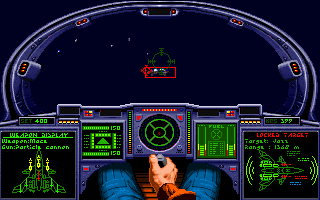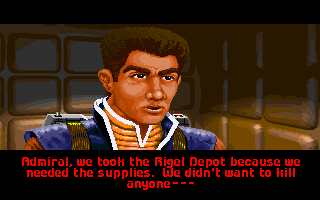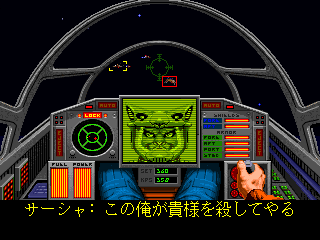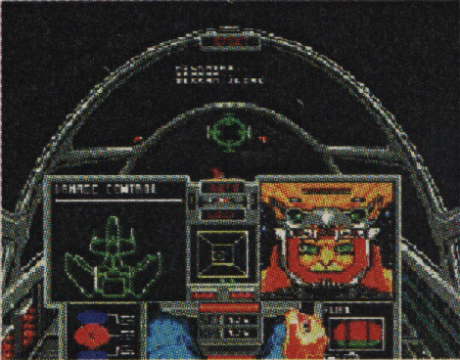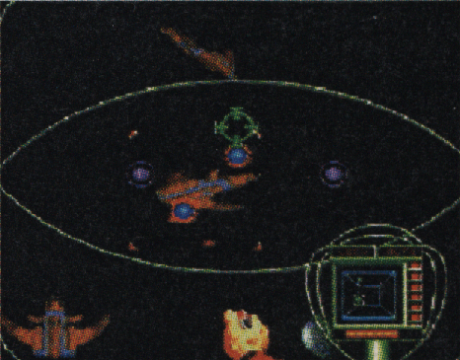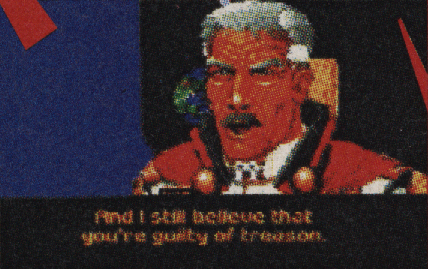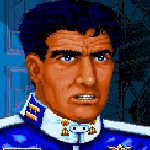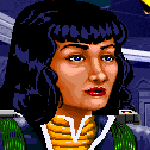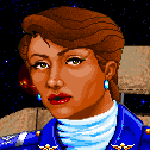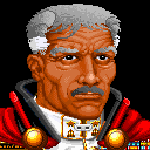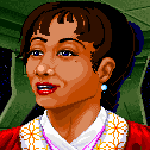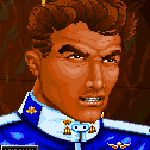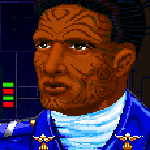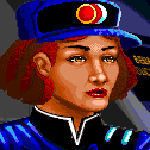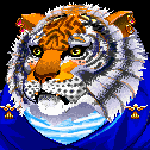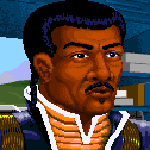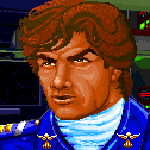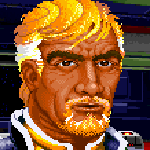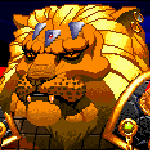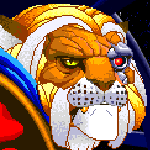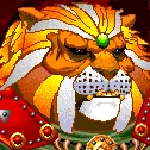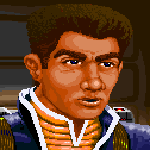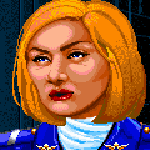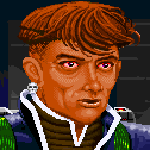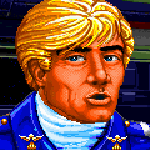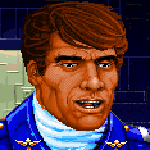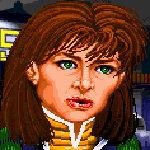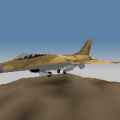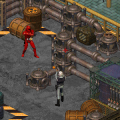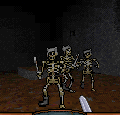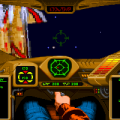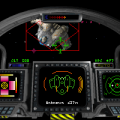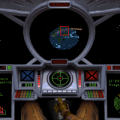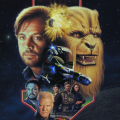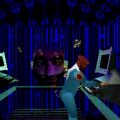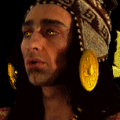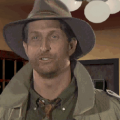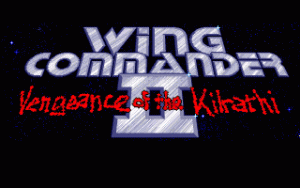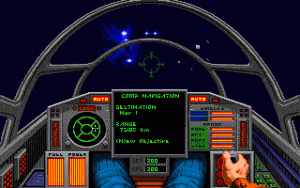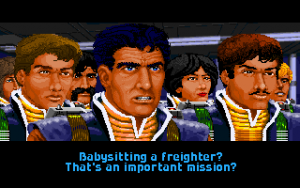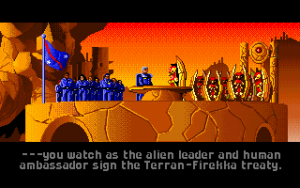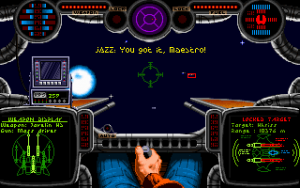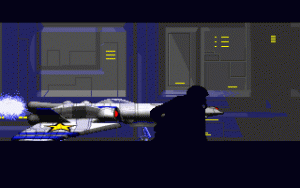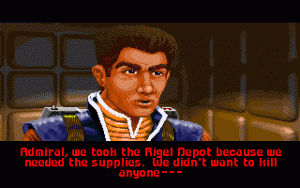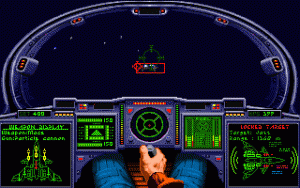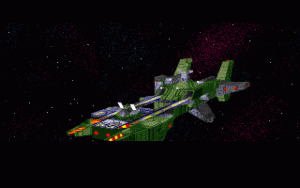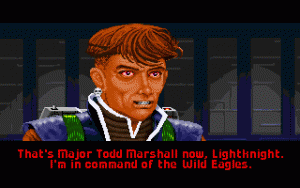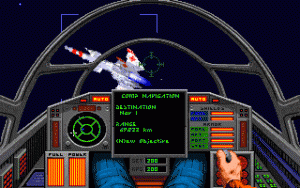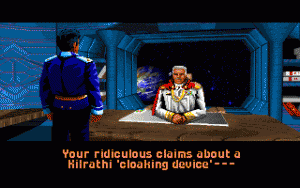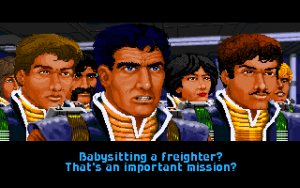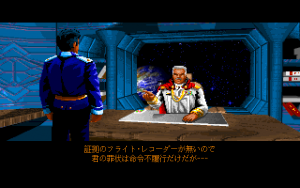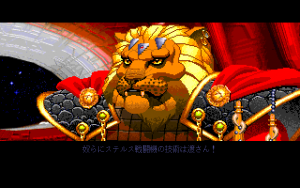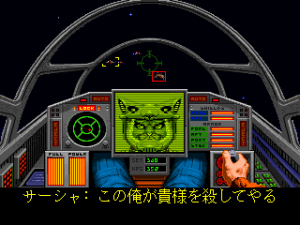- Wing Commander (Series Introduction)
- Wing Commander
- Wing Commander II: Vengeance of the Kilrathi
- Strike Commander
- Wing Commander: Academy
- Wing Commander: Privateer
- Wing Commander: Armada
Tense music plays as a ship appears in the blackness of space. It’s the TCS Tiger’s Claw. Your home for all of Wing Commander, now in maneouvres behind enemy lines. Suddenly, three Kilrathi starfighters appear from thin air, and unload torpedoes in a surprise attack! The Tiger’s Claw is destroyed with all hands.
And the Confederation has chosen to blame you for it.
As the Emperor of the Kilrathi and Crown Prince Thrakhath celebrate this latest victory, the pesky human pilot that has gotten in the way of their plans is paying for it. Indeed, Admiral Tolwyn, who presided over your court martial, calls you a traitor to your face, accusing you of collusion with the Kilrathi. He refuses to believe your side of the story: you saw the Kilrathi stealth fighters, which can become invisible on a whim. You have no evidence, of course. But since the court couldn’t find any solid evidence of treason, all they can do is demote you to Captain and ask you for your resignation and admission of guilt. You refuse… and are reassigned to InSystem Security. As glorified chaperone to convoys far from enemy lines, you’ll be out of sight and out of mind in the backwater of Caernarvon station. Ten years pass.
As you can see, Wing Commander II wastes no time in ramping up the stakes and shaking off the status quo from the first game. Your beloved carrier is gone, your high rank, painstakingly attained through countless missions, is also gone. Demoted, defamed, all while the Kilrathi advance their plans. But it’s not long before you’re back in the frontlines with allies old and new, fighting shoulder-to-shoulder with Kilrathi defectors, and trying to uncover the conspiracy behind the destruction of the Tiger’s Claw.
Wing Commander II follows in the footsteps of its predecessor with an improved version of the same Origin FX graphics engine. But everything feels more alive: bigger portrait sprites, CGI-rendered, albeit brief, ship fly-by shots, more characters, and even cutscenes showing what Kilrathi characters are doing! It was more of the same, only better, with a broadened scope allowing for a more epic story. But despite what the intro cinematic claimed, this wasn’t, strictly, a Chris Roberts game.
Development on sequel had already begun by late 1990, under the provisional title Wing Commander II: Cloak and Dagger. Roberts was involved in WC2 at its inception, but it’s clear from interviews at the time that the planned game and its features were very different from the end product. Chris Roberts was now a permanent staffer at Origin, as Director of New Technologies, and gave up lead programming and directorial duties to focus on a new property: Strike Commander. The long-term plan was for Strike to act as a testbed for a new engine to be used in the already-approved Wing Commander III.
The heavy task of leading Wing Commander II, meanwhile, was given to Siobhan Beeman. Beeman had been involved in programming and design duties for the first game, most notably its dogfights, and had assisted with programming for the Secret Missions. But she now had the requisite directorial experience, having just delivered the Ultima spin-off, Savage Empire. Beeman was familiar with the universe, the game engine, and the story, and now had proven her directorial chops.
The project was given another very fast turnaround of just 9 months. The team realised that delivering another groundbreaking experience was not feasible. Instead, they would polish off the rough edges from Wing Commander, with more detailed graphics, sophisticated storytelling, and improved cutscene quality. Beeman called this approach ‘Wing Commander on steroids’.
One of the key features of the new game was the inclusion of digitized speech. For the 1991 Consumer Electronics Show, Origin aimed to dazzle people on the showfloor again. Playing around with her new Sound Blaster card, Beeman used a consumer-grade microphone and the card’s software to record some lines to be included in the CES demo. While rougher than the final product, it was enough to generate buzz around the highly-anticipated sequel.
On the technical side of things, the game largely plays the same as its predecessor. You go out on a mission, clear selected nav points of enemy fighters and capital ships, and return to base. The branching mission system is back, based on the same ‘victory/failure’ conditions, but it is significantly simplified compared to the first game. The ‘failure track’ was almost identical to the winning one, and failing two sets of missions in succession resulted in an immediate Game Over. This was in response to player feedback regarding one of the least popular mechanics of the original. The fact the game provided harder, not easier, missions when the player had failed, frustrated users, who would instead reload a game to replay the mission.
Another significant change is the removal of the performance-based promotion and medal system. This was discarded intentionally, since the main character’s demotion to Captain, and his slow climb back through the ranks, plays out as part of the storyline. In other words, any promotions are due to the storyline, and not to your skills in the cockpit.
Improvements, however, are all over the place. The enemy AI was re-programmed into one that scales its skill with the player’s, to help avoid massive difficulty spikes which players had complained about in the Secret Mission packs. All ships are brand new, including heavy bombers with turret emplacements that could be controlled by the player. To add a layer of strategy, the only way to destroy capital ships now was with slow-locking torpedoes, available only on bombers.
The in-game graphics for all ships have been vastly improved thanks to the hiring of 3D artists working on Autodesk 3D. These detailed models were best shown off in their brief cutscene appearances, such as the memorable, if endlessly repeated, establishing shot of Prince Thrakhath’s flagship.
On the audio end, while George “The Fatman” Sanger returned to compose the main theme and some other tracks, he was not interested in doing further work on the project. Origin Audio Director, Martin Galway, hired Dana Glover to work on music composition. Together, they brought life to the games darker themes, most famously with Prince Thrakhath’s Theme. Galway was also tasked to bring Beeman’s vision of voiced cutscenes to life, recruiting Origin staff members for the job in the company’s first foray into digitized speech. The end result was less ambitious, resulting only in in-flight voices and some cutscenes receiving the digitized speech treatment. Moreover, the additional storage space required would have added three high density floppies to the already-mammoth seven of the base game. It was decided to release the speech files separately, as the Speech Accessory Pack, launched simultaneously with the base game. Future CD-ROM versions and re-releases would include the pack, alongside the two Special Operations mission packs.
The first game’s writer, Jeff George, had moved on to directing projects and was thus unavailable. Freelancer Ellen Guon, was added to the team in lead writing duties. While some development timelines indicate she only joined after delivering Secret Missions 2, the first internal story pitch for Wing Commander II, which she co-authored with Siobhan Beeman, dates to November 1990.
The scaling down of the mission branching system and removal of promotions helped the team focus on the storyline. Roberts’ main request was for the tale to go to darker places than its more fresh-faced predecessor. Comparisons to Star Wars are inevitable when talking about the Wing Commander series, and Roberts was ready for his sci-fi saga to follow the footsteps of The Empire Strikes Back. With Jeff George gone, Roberts’ inclinations towards a story with shades of grey had come back in force.
The storyline picks up ten years after Secret Missions 2, as the player character finds himself suddenly in the frontlines again when the TCS Concordia, a state-of-the-art carrier, arrives in the sector in need of assistance. Rather conveniently, the Concordia plays host to a number of returning faces from the previous games, including most survivors of the Tiger’s Claw, and your worst enemy in ConFed as commanding officer: Admiral Tolwyn. To further illustrate the low regard fellow pilots hold for the player, the character of Ralgha “Hobbes” nar Hhallas is introduced. He’s the Kilrathi defector who provided intel and ships in Secret Missions 2, and his service as a talented, reliable ConFed pilot, make him a trusted member of the Concordia’s crew. While serving as a stark reminder of the player’s position in the ship, Hobbes goes on to forge a friendship with the player, and provides a welcome development in the characterization of the Kilrathi. In other words, he’s not a cackling, evil murderer but an honest, honorable soldier. The main plotline involves a campaign to secure the tactically crucial Enigma Sector for the Confederation. This area of space provides an incredible tactical advantage, allowing ships to traverse the entire sector in a single jump. The Kilrathi and the Confederation both race to establish dominance over the sector.
Compared to its predecessor, it’s easy to think of Wing Commander II as a much safer effort, but it wasn’t without ambition. Many features teased earlier on had to be nixed in order to focus the team’s work on the necessary improvements to the engine, audio, and storyline. Among these were ideas about making the player character customizable, multiplayer modes through modems, and even a mission construction set for both Wing Commander I & II were mooted. Ultimately, none of these would be included in the final game, but would serve to inspire future spin-offs Wing Commander: Armada and Wing Commander: Academy. The game’s most lasting contribution to the series, gameplay-wise, was also a small, quality-of-life upgrade: the ITTS system. The game calculates the trajectory of an enemy fighter, and provides a moving target reticle indicating where the player should be aiming their guns in order to hit the enemy. This helps do away with the complexities of mentally calculating the speed and trajectory of your target.
The story certainly remains gripping, with plenty twists, turns, betrayals and a lot of dead pilots. While it is much more playable than its predecessor due to tighter game code, some parts of the story leave a lot to be desired. Bluehair is a more active presence in the story, but he doesn’t have much to say aside from frustration at being labelled a traitor, and being sad when his friends, inevitably, die in missions. The game also seems intent on killing female pilots in particular, for cheap tugs at the heartstrings. Regardless, it definitely expanded on the Wing Commander world, and Beeman’s team ensured the game would look and play amazing, but it’s not without its flaws.
Despite its cut features, Wing Commander II was another mega-hit for Origin, with anecdotal information estimating as many as half a million copies shipped. The more engaging storyline, despite sacrificing features from the first game, was a massive hit with players, for whom Vengeance of the Kilrathi was a dream come true. Origin had pulled all the stops in making the game its fans wanted, right down to the addition of an, admittedly, slightly ropey romance with fellow pilot Angel. With the successful mission pack marketing model of the first game in mind, they went on to develop two such packs for the sequel, this time titled Special Operations 1 & 2.
Ports and Expansions
The first pack, Special Operations 1, was released in December 1991, a mere 3 months after the core game, and brought with it a new playable bomber, the maneuverable Crossbow, and a new enemy fighter, the Gothri (although this made heavy use of the existing model for the Dralthi fighter). The player was introduced to new pilot Bear, and a chaotic situation to delve into. While victorious in the Enigma Sector campaign, the player now has to contend with a Kilrathi counter-offensive after many of their colonies rebel. As if that wasn’t enough, the crew of a ConFed ship has mutinied and taken to piracy, meaning you now have to shoot at your own people to bring them to justice. If you had a Sound Blaster-compatible card, Special Operations 1 included more digitized speech for you to enjoy.
The follow-up, Special Operations 2 wouldn’t appear until June 1992, and it’s notable for being the final installment of the main series on the Origin FX engine, as well as the final game in the series that allowed the player to import a save game from a prior installment. This meant that by the end of SO2, a player could have upwards of a thousand kills!
The story brings us back to the traitor revealed at the end of the base game, a fellow pilot and member of the Society of Mandarins, a cult-like group of humans that work to advance the Kilrathi cause. Said pilot escapes and takes command of the Mandarins just as you’re assigned to assist in the testing of the Morningstar, ConFed’s latest experimental fighter. Leading the test is Wild Eagle squadron, headed by your old friend Maniac. Players could now pilot this space superiority fighter and deploy its deadly payload: the ‘Mace’ nuclear missile. It’s not long before the Mandarins get wind of the Morningstar project and attempt to steal it for their own nefarious ends. Like the first pack, digitized speech is available for in-flight exchanges and some cutscenes, and new characters from Maniac’s squadron are introduced to the story.
While it clearly focused on giving the players more of what they wanted, rather than really shaking things up, Wing Commander II’s development came at a rather complex time in the history of Origin, which would culminate in its acquisition, in late 1992, by Electronic Arts. The now-legendary Ultima VII was in development, sharing some of its writing talent with Wing Commander II, but mostly reaping the benefits from its success. Indeed, as epic and expansive as WC2 was, it also felt rather rushed. The gripping storyline and technical advances did a great job of hiding the fact that when you got down to it, Wing Commander was a more fully-featured experience, even if its story was relatively lackluster in comparison to its sequel. On the simulation side of things, Origin was hoping to push the envelope with the Chris Roberts-directed Strike Commander, which would ship in 1993 after many delays. Despite it not being officially part of the series, that’s where our history takes us next.
Before we do that, let’s take a look at the requisite ports a game with the level of success of Wing Commander II would surely warrant. As its older brother was being ported to every system under the sun, from rare Japanese computers to Nintendo and Sega systems, Vengeance of the Kilrathi and its mission packs were ported to… just one system, the FM Towns. This was done with the game’s Deluxe Edition, which packaged the base game, Speech Accessory Pack, and both Special Operations add-ons. The only major change to this port is, once again, the addition of Redbook audio tracks on the CD, rather than MIDI, for the music.
It’s surprising, to be sure, to find out that only one other planned port of the game existed, developed for the SNES. This game was never released, but we know for a fact it had reached an advanced stage in development, being pulled not long before going into duplication and publishing. Magazine articles wrote about the port and printed fuzzy screenshots, but no ROM of it has ever appeared on the internet. Interviewed on the topic, the SNES port Director, Billy Cain (who would go on to work on Wing Commander: Prophecy, among others), stated the reasons for pulling the release were most likely financial. The port was slated for a Summer 1995 release, at a time when sales of SNES games were starting to slow down, and it’s speculated that Electronic Arts simply did not want to take that risk. As we will see later, something had happened in 1994 that made Wing Commander II look, frankly, outdated and outclassed.
Aside from the aforementioned Deluxe Edition, the game saw numerous re-releases alongside games from other series much like its predecessor. It was also included in the Kilrathi Saga compilation, with the Special Operations packs as downloadable optional content. Just like the first game, this version also had the option to toggle the cockpit off, as well as a ‘re-orchestrated’, digital soundtrack. The music, however, proves to be disappointing, as these new arrangements (which are still synths and not actual orchestra recordings) lack much of the ‘oomph’ of tracks like the iconic theme of Prince Thrakhath.
Wing Commander II can be purchased from GOG packaged with the first game, and their release is based on the Deluxe Edition.
DRAMATIS PERSONAE
You (“Bluehair Ourhero”)
You are a Captain in InSystem Security, assigned to the backwater Caernarvon Station alongside your wingman, Shadow. ConFed high command considers you a traitor, you’ve lost your good name, your friends, your home and your position, but not your talent for flying. Soon enough you’ll meet with many survivors from the Claw aboard the TCS Concordia. Your name and callsign are blank once more, as well as your first name, to be filled in by the player when they start a new game. You still have blue hair, and even though many dislike you, I still think you’re swell.
Captain Elizabeth “Shadow” Norwood
Your wingman at Caernarvon station. After spending a decade flying missions and working together, you’ve forged a strong friendship with Shadow. Sarcastic in a loving manner, Shadow is an able pilot to be sure, but nowhere near an ace, living the life of the backline reservist. She’s loyal to you and requests your transfer to the Concordia due to your rather obvious talents in the cockpit. Shadow’s lack of dogfighting experience made her anxious to fly combat missions, but she did it anyway. She’s one month away from retirement as the game begins…
Colonel Jeannette “Angel” Deveraux
Now the commander of the TCS Concordia’s fighter wing, Angel wants to believe your innocence, but is haunted by the ghosts of the Claw. Ever the efficient soldier, she still jumps into the cockpit to take part in missions. Over the course of the game, you will become closer with Angel after you comfort each other over the loss of a cherished friend. She still inserts gratuitous French everywhere, mon ami, but does it a bit less. She’s the game’s titular Wing Commander, as you once again do not command an entire fighter wing.
Admiral Geoffrey Tolwyn
Tolwyn presided over your court martial, considers you a traitor, and hates your guts. Just your luck that you end up on his flagship, the TCS Concordia. You’ll have to really prove yourself to earn his respect, and that includes figuring out the secrets of the conspiracy aboard the Concordia, which might just be connected to the destruction of the Tiger’s Claw. His title as ‘Sir’ Geoffrey Tolwyn is indicative of his English aristocratic background.
Lt. Colonel Mariko “Spirit” Tanaka
Still close to you and Angel, Spirit refuses to believe you are a traitor, and treats you as warmly as ever. She’s still a careful pilot, and got engaged at some point prior to the Firekka campaign. Her fiance has been taken prisoner by the Kilrathi, with the Society of Mandarins trying to use this as leverage to convince her to betray the Confederation.
Major Zach “Jazz” Colson
The years have not made Jazz any friendlier. If anything, his skill in the cockpit has resulted in an even more inflated ego. He’s quite content to needle you about your disgrace, not caring one iota about how you might have felt about the Claw. But there’s more to Jazz than the bluster, as you will find out throughout the main campaign. The greater luxuries afforded to a high-tech vessel like the Concordia mean he is now frequently seen in the observation deck, playing on a grand piano.
Lt. Colonel Etienne “Doomsday” Monclair
One of the Concordia’s aces, Doomsday retains his rather glum manner. While this often depresses his co-pilots, they still find him an able wingman and a good companion for the frequent poker games in the Concordia’s barracks.
Chief Petty Officer Janet “Sparks” McCullough
A flight deck technician, Sparks befriends you on the Concordia, and is always good to hear the latest scuttlebutt going on behind the scenes. Little on the Concordia escapes Sparks attention, and many share secrets in her presence due to her unassuming nature. Trustworthy and friendly, she thinks something is amiss in the ship. In gameplay terms, she’s the one to provide you with a performance report after a mission. Your conversations with her serve to list the damage you sustained and your kill count.
Colonel Ralgha “Hobbes” nar Hhallas
The Kilrathi defector from Ghorah Khar, Hobbes is now an enlisted ConFed pilot in the Concordia’s fighter wing. A considerate and honorable warrior, Hobbes has earned the respect of his fellow pilots, who would much rather fly with this decent Kilrathi on their wing than you. His tendency to ponder socio-philosophical issues has earned him the callsign Hobbes, after the Earth philosopher of the same name and not, as you might think, after any cartoon tigers from popular comic books.
Lieutenant Ross “Downtown” Baldwin
Baldwin was very young when he and many other humans ended up captured and taken as slaves to the Kilrathi world of Ghorah Khar. He was about to be executed for a minor transgression, but was saved by Ralgha who saw this as a dishonorable action. They have had a close bond ever since, with Downtown bestowing the Hobbes moniker on his Kilrathi friend. He’s well-versed in Kilrathi traditions, as well as the situation surrounding the traitorous Society of Mandarins.
Captain Dirk “Stingray” Wright
Stingray is as blunt as they come: he considers you the ‘coward of K’Thitrak Mang’, and never fails to remind you that he hates you as much as he hates the Kilrathi as a race. This caused frequent clashes with both Hobbes and Blair, sometimes resulting in fistfights that had one or more of the three removed from the flight roster. Stingray is implicated in a murder aboard the Concordia, but all is not as it seems… While not present in future installments, Stingray is notable for being a one-off character with a fleshed out storyline after Wing Commander II, retiring as a general after the events of Wing Commander: Prophecy.
Colonel James “Paladin” Taggart
Way past the age of retirement for pilots, Paladin is now working in Covert Ops with his advanced freighter, the Bonnie Heather. He also trusts and believes you, and in the past decade has developed a rapport with Hobbes. You’ll fly alongside the Heather on many missions, later joining Paladin in the Special Operations division. Paladin’s still fae Scotland, laddie, but his lilt is a wee bit less pronounced the noo.
Prince Thrakhath nar Kiranka
We finally see Thrakhath in person, as he is in command of K’Thitrak Mang, Kilrathi HQ for the main campaign’s Enigma Sector setting. Thrakhath is ruthless and cunning, placing an emphasis on subterfuge and technological superiority, rather than sheer brute force, to achieve the Empire’s goals. While proud of his new stealth fighter technology, the advance of the Ghorah Khar rebellion results in him destroying much of that knowledge to avoid its falling into Terran hands. He takes to the cockpit in his advanced superfighter, the Bloodfang, and must be faced by the player.
The Kilrathi Emperor (Joor’rad nar Kiranka)
Never named in any of the games, the Emperor is an older Kilrathi with a cybernetic eye. He’s never characterised in depth, often seen receiving situation reports from his heir, Thrakhath. What little we know of him is that he is a traditionalist, less concerned with the ins and outs of technological advancement than he is with battle tactics and grand strategy.
Khasra Redclaw
A member of the royal family, Khasra serves under his cousin, Thrakhath. However, Khasra is deeply unimpressed with his superiors, seeing the Emperor as old and weak, and his cousin as incompetent. His treasonous ways haven’t resulted in any actual mutinies… for now.
Lieutenant Jason “Bear” Bordarevsky
Bear was part of the mutiny aboard the TCS Gettysburg, caused by the crew’s refusal of his commanding officer’s orders to destroy unarmed civilian transports. The crew then split into two camps, with one wanting to pursue a life of piracy, and the other, which Bear was part of, eager to return to ConFed. Labelled as a traitor when sent to negotiate with the Concordia, Bear helped give context to the situation aboard the Gettysburg, and his help landed him a spot on the Concordia’s flight roster. His family is of mixed Russian-Australian heritage.
Major Edmond
The comms officer of the TCS Concordia, she joins you in the Special Operations alongside Paladin.
Major Todd “Maniac” Marshall
You would think a decade of experience in the field would temper Maniac so that he might, at least, start behaving more responsibly. But you’d be wrong: he’s still ever the hot-shot taking needless risks for the sake of looking good. His skill in the cockpit is still incredible, with a kill count that landed him the command of the Wild Eagle test pilot squad.
Lieutenant Jeffrey “Talon” Burkheimer
A pilot in Maniac’s Wild Eagle squadron, Talon’s unusual hobby is a keen interest in Kilrathi culture and history. A fluent speaker of Kilrathi language, the fresh-faced Talon’s knowledge of Kilrathi battle tactics is expansive.
Lieutenant Markham “Crossbones” Colt
The grim-faced Crossbones is another daring ace under Maniac’s command, and considers him a role model. He has a devil-may-care attitude to his own survival, which resulted in his callsign. He’s not impressed by your flight record, and prefers to dwell on your failures rather than your triumphs.
Captain Maria “Minx” Grimaldi
Another pilot under Maniac’s command, Minx is straightforward and quite flirty, constantly pushing at your boundaries and even kissing you when she thinks you’re lonely. Like the rest of the Wild Eagles, she follows Maniac’s lead in the cockpit, often taking needless risks that end up with her priceless prototype fighter badly damaged.
Image credits
All cover art from Mobygames
SNES WC2 screenshots based on magazine scans from the Wing Commander Encyclopedia maintained by WCNews: https://www.wcnews.com/wcpedia/Main_Page
All other screenshots from Mobygames
Spirit and Khasra WC2 portraits from Wing Commander Information Center Wiki https://wingcommander.fandom.com/wiki/
WC2 Doomsday, Minx, Talon and Edmond Portraits from Mobygames
All other character portraits from WCNews Encyclopedia
